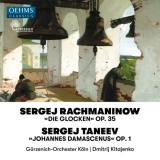 Sergei Rachmaninov: Die Glocken (The Bells), op. 35; Sergei Taneyev: Johannes Damascenus (John of Damascus), op. 1; Anna Samuil Soprano, Dmytro Popov, Tenor, Vladislav Sulimsky, Bariton, Czech Philharmonic Choir Brno, Gürzenich-Orchester Köln, Dmitrij Kitajenko; 1 CD Oehms Classics OC 470, Aufnahmen 06/2018, Veröffentlichung 17/07/2020 (64'44) - Rezension von Remy Franck
Sergei Rachmaninov: Die Glocken (The Bells), op. 35; Sergei Taneyev: Johannes Damascenus (John of Damascus), op. 1; Anna Samuil Soprano, Dmytro Popov, Tenor, Vladislav Sulimsky, Bariton, Czech Philharmonic Choir Brno, Gürzenich-Orchester Köln, Dmitrij Kitajenko; 1 CD Oehms Classics OC 470, Aufnahmen 06/2018, Veröffentlichung 17/07/2020 (64'44) - Rezension von Remy Franck
Absolute Kontrolle des musikalischen Geschehens, perfekte Verwaltung der Farben und der Dynamik und kontinuierlich spannendes Musizieren zeichnen diese neuen Kitajenko-Einspielungen aus.
Sergei Rachmaninovs Vokalwerk Die Glocken beschreibt, frei nach Edgar Allan Poe, die vier großen Lebensabschnitte des Menschen. In den vier Teilen werden die Klänge von Schlitten-, Hochzeits-, Alarm- und Totenglocken evokativ dargestellt. Die Schlittenfahrt am Anfang ist ein typisches ‘Mütterchen Russland’-Tableau, das in dieser Aufnahme in schillernden Farben erklingt, mit dem imponierenden Tenorsolo des glückstrahlenden Dmytro Popov.
Rachmaninov hat den zweiten Satz sehr meditativ angelegt, mit viel Melancholie und ohne unmittelbare Freude. Unter Kitajenkos Leitung entwickelt sich der Satz in einem großen Espressivo, das mit feinen Modifikationen in Tempo und Dynamik eine erstaunliche Vielfältigkeit der Färbungen ergibt. Der Dirigent hat das Formgefühl und die Ruhe, bei denen das Melos zu singen anfängt und die Deklamation plastisch wird. Anna Samuil singt das Solo sehr ausdrucksvoll.
Im dramatischen dritten Satz, den ‘Sturmglocken’ beim Ausbruch einer Feuersbrunst, sorgten Chor und Orchester zusammen für eine dramatische Kraftentfaltung ohne Exzesse, weil Kitajenko den harmonischen Ausgleich aller Kräfte so steuert, dass der Satz erregend gesteigert wird, ohne das ihm innewohnende Mysterium zu verlieren.
Mit der kräftigen Baritonstimme von Vladislav Sulimsky und dem prägnanten Chorgesang des Chors aus Brünn sowie dem fein abgestuften Klang des Gürzenich-Orchesters kommt es im letzten Teil, den ‘Todesglocken’, zu einer geistigen Durchdringung jeden Tons und jeden Motivs, wie man es nur allzu selten erleben kann. Kitajenkos Einfühlungskraft lässt ihn in die Tiefe reichen und der Musik das Schaurige geben, das der Komponist in diese Musik gelegt hat.
Sergei Taneyevs Kantate Johannes Damascenus für gemischten Chor und Orchester ist ein wunderbares Werk, das der Komponist, ohne seine russischen Wurzeln zu verleugnen, als eine Hommage an Johann Sebastian Bach ansah. Trotz des strengen Kontrapunkts kommt in dieser Aufführung viel Ausdrucksstärke zum Tragen, sowohl im bewegend meditativen ersten Teil wie auch im Hoffnungsaufschwung der abschließenden Erlösungsmusik. In den formenden Händen von Dmitrij Kitajenko erreicht der Philharmonische Chor aus Brno eine einfühlsame, sehr plastische Deklamation, die zusammen mit dem differenzierten Orchesterklang eine wirkliche Perspektive erlangt, eben durch dieses Anfang und Ende verbindende, horizontale, die ganze Komposition umfassende Denken des Dirigenten, das aber nicht nur die organische Geschlossenheit ergibt, sondern durch die subtile Verfeinerung die Faszinationskraft des absolut Richtigen erreicht. Intensität wird hier nicht von Lautstärke und schnellen Tempi hervorgerufen, sondern von der Feinfühligkeit eines Dirigenten, bei dem die Klarheit des künstlerischen Erkennens und dessen Umsetzung ins künstlerische Wollen oberste Richtlinien sind.
Die unerhört geistreichen Interpretationen der zwei Werke lassen diese Produktion von Oehms Classics zu einem in allen Hinsichten herausragenden Tondokument werden.
Absolute control of the musical action, perfect management of colours and dynamics and continuously exciting music-making characterize these new Kitajenko recordings.
Sergei Rachmaninov’s vocal work The Bells describes, loosely based on Edgar Allan Poe, the four great stages of man’s life. In the four parts the sounds of sleigh bells, wedding bells, alarm bells and death bells are evocatively represented. The sleigh ride at the beginning is a typical ‘Mother Russia’ tableau, which in this recording is getting dazzling colours. Also impressive is the tenor solo of the radiant Dmytro Popov.
The second movement, Wedding Bells, is very meditative, with much melancholy and without immediate joy. Under Kitajenko’s direction, it develops in a great espressivo, which, with fine modifications in tempo and dynamics, results in an astonishing variety of colours. The conductor has the sense of form and the calm at which the melos begins to sing and the declamation becomes highly graphic. Anna Samuil sings the solo very expressively.
In the dramatic third movement, Alarm Bells, the choir and orchestra together provide a dramatic display of power without excesses, because Kitajenko controls the harmonic balance of all forces in such a way that the movement is excitingly progressing without losing its inherent mystery.
With the powerful baritone voice of Vladislav Sulimsky and the concise choral singing of the Brno Philharmonic Choir, as well as the finely shaped sound of the Gürzenich Orchestra, the last part, Death Bells, leads to a spiritual penetration of every note and every motif, as one can only too rarely experience. Kitajenko’s empathy allows him to reach into the depths and give the music the eerie quality that the composer has put into this music.
Sergei Taneyev’s cantata ‘John of Damascus’ for mixed choir and orchestra is a wonderful work, which the composer, without denying his Russian roots, saw as a homage to Johann Sebastian Bach. In spite of the strict counterpoint, there is a great deal of expressiveness in this performance, both in the movingly meditative first part and in the upswing of hope in the concluding salvation music. In the formative hands of Dmitrij Kitajenko, the Brno Philharmonic Choir achieves a sensitive, very plastic declamation, which, together with the differentiated orchestral sound, acquires a real perspective, precisely through this beginning and end connecting horizontal thinking of the conductor. It encompasses the whole composition and does not only produce the organic unity, but through subtle refinement, achieves the fascination of the absolutely right, with an intensity that is not caused by volume and fast tempi, but by the sensitivity of a conductor for whom the clarity of artistic recognition and its translation into artistic will are the highest guidelines.
The incredibly witty interpretations of the two works make this production of Oehms Classics an outstanding sound document in all respects.
























